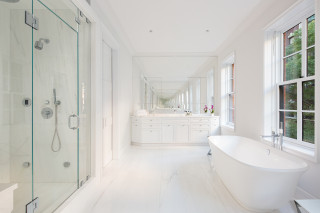In the WALL STREET JOURNAL: Sales of new homes are near 47-year lows, yet the supply of new and existing homes is expected to grow in the months ahead as construction ramps up and a wave of foreclosed homes hits the market.
LUXURYlesson: “While the USA in general will experience increases in inventories, the luxury market in Manhattan will see moderate inventory gains,” says Leonard Steinberg, Managing Director of Prudential Douglas Elliman. ” Yes, there is shadow inventory, and yes we will see a rise in foreclosures, but these will exist in the lower echelons of the luxury market. Manhattan should not be confused with the NEW YORK MARKET that includes Brooklyn and Queens. Building permits are at an all-time low. Certain classifications of real estate in some areas are in short supply, and those that are planned to fill this need are 2-3 years away from delivery.”
In June, new-home sales were running at a seasonally adjusted annual rate of 330,000 units, the Commerce Department said Monday. While that was up 23.6% from the all-time low of 267,000 in May, the June figures were the second lowest on record.
“What we’re really seeing here is that new-home sales are at what I’d call rock bottom,” said Steve Blitz, an economist at Majestic Research in New York. “The last time we were running these kinds of numbers was the 1982-1983 recession, when we had 100 million less people.”
LPS Applied Analytics, a firm that tracks mortgage data, said Monday that there were 4.56 million loans in default or in some stage of foreclosure in June, down slightly from May. But the number of new foreclosures initiated on properties backed by Fannie Mae and Freddie Mac increased sharply, rising 21% in June from May.
The rise in foreclosures on Fannie and Freddie properties reflects the failure of many troubled borrowers to receive permanent loan modifications plans, analysts said. Having exhausted all options to rescue their homes, many troubled borrowers may now be giving up.
“Looking at the numbers you’re seeing about this pickup in foreclosure starts, it’s hard to see how it’s not going to translate into elevated levels of [properties taken over by banks] down the road,” said Herb Blecher, an analyst at LPS.
Home builders, which began buying up land lots late last year in anticipation of an economic and housing rebound, are stuck with thousands of acres that are prone to lose value as the market struggles. Many will build homes on the land, rather than write off its value and wait for the market to improve.
“Builders are willing to pay a premium to not have that risk on their hands. They’re still facing a tremendous amount of stress,” said Brad Hunter, chief economist at Metrostudy, a housing-market research firm based in Houston. “They’re discounting the homes, they’re making very small profit margins, but they’re building homes. They’re very interested in securing market share.”
Several former bubble markets are seeing the biggest increase in home construction. According to Metrostudy, new-home starts in the second quarter show signs of rising 68.1% in South Florida, 83.7% in Naples/Ft. Myers, 65.1% in Las Vegas and 59.7% in Denver from the same period in 2009.
Other indicators also point to builders preparing to increase home construction, despite lagging sales. The number of finished vacant lots, or parcels of land that have been developed and readied for building, stands at about 1.2 million nationwide, according to Metrostudy, or just 5% below the peak in late 2008.
Most metro areas are flush with vacant homes as well: Metrostudy found that of the 48 metro areas the firm covers, only four—northern Virginia, San Antonio, Houston and Baltimore—have what is considered a “balanced” inventory of unsold homes, or about three months’ supply or less.
Coastal Southern California, which includes many of the cities near Los Angeles, has an ample supply of builder-ready land—about two years’ worth—owned by banks, developers, investors, the government and the builders themselves, which are starting construction in earnest.
Irvine Co., a large land developer and master planner in the coastal region, said it presold 570 homes in the northern portion of its Irvine Ranch project in the first six months of the year, and the $300 million construction will begin soon. The company also has plans to start 700 to 800 additional homes in the coming months, using builders both public and private, including KB Home Inc., TRI Pointe Homes Inc., Van Daele Homes and Brookfield Homes.
“We’re doubling down,” said Dan Young, who heads Irvine Co.’s community-development and home-building division. “While the national home builder is probably still right to say things are still weak, and the mass market is not back, we are seeing improvements in local markets.”
But as inventories grow, it could put further downward pressure on home prices. The median price of a new single-family home has been falling steadily since its 2007 peak of $247,000. Monday’s numbers put the median price in June at $213,400.
Credit Suisse analyst Dan Oppenheim wrote in a note Monday that sales are probably worse than the Commerce Department’s initial report and predicted further declines in home prices, based on continued weak demand.
“The low level of activity [even with the reported increase] is well below desired absorption levels of builders and will lead to additional pressure on home prices,” he wrote.
